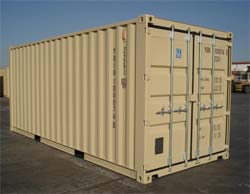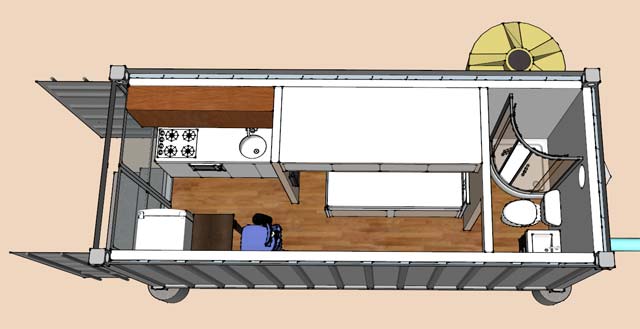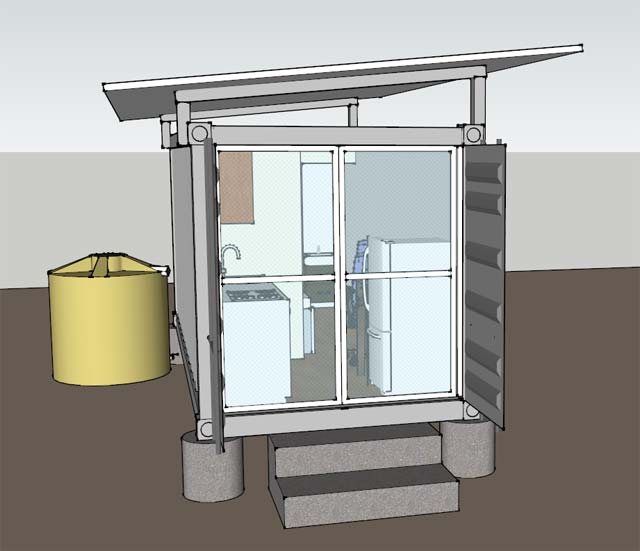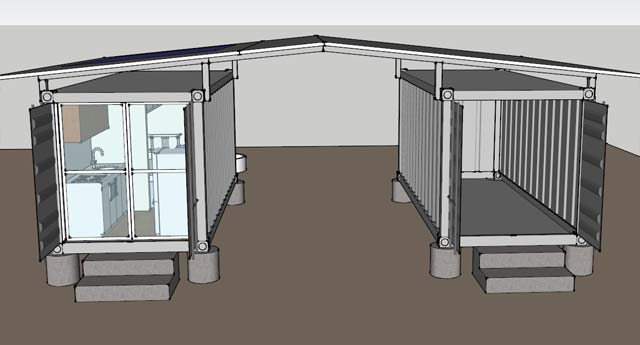Living in a shipping container
 Would you want to live on 12 square meters? I was thinking about this as I got busy drawing up a 20 foot shipping container home in Sketchup.
Would you want to live on 12 square meters? I was thinking about this as I got busy drawing up a 20 foot shipping container home in Sketchup.
Shipping containers are relatively cheap and sturdy, and saves a lot of time when building a tiny cottage. They also lock up safely. And when you get bored with your surroundings, you just load it up on a truck and move somewhere else, taking your home with you.
It is minimalist living to an extreme, where not a square meter goes to waste, see below drawing. The inside is lined with Styrofoam to provide some heat and sound insulation, and then covered with drywall. This also makes the wall smooth, instead of following the corrugated pattern of the container. The space is partitioned into an inner bathroom, a bedroom with flat screen TV, and a kitchen with a table you can use for eating and working. Above and below the bed are storage spaces.
The home does not have windows, in order to keep its full required rigidity during shipping. This also makes it look more anonymous, so you can leave the container sitting somewhere for months, without worrying too much.
When you are at home, the main doors are typically open, with screen doors closed to keep bugs out. The main doors should be locked open, so intruders are prevented from locking you in. Air flows through a ventilation duct in the bathroom.

The home has a simple roof to protect it from the heat of the sun. On the roof are solar panels to charge a battery that powers the appliances.
An outside tank collects rainwater that you filter and use in the bathroom and kitchen. In dry climates a well must be dug instead. Gray water runs into a gravel bank in the ground, and black water runs in a pipe to a dug well at a distance from the home. Optionally a composting toilet can be used.
The container sits on four feet of concrete, and there are some stairs to get in and out. These are poured on location and left behind when you move.

Inner dimensions: 5,75 m long, 2,10 m wide, 2,20 m ceiling height. Bed 2,00 m x 1,10 m. Bathroom entrance 2,00 m by 0.70 m.
To get more storage space for tools, and a shaded area to relax or work, an additional container can be used. The roof is extended to cover the entire area.

Perhaps this is a bit tight on space for most people. But for a certain adventurous group, this could be an interesting life style.
Imagine a company that offers space for these containers in various attractive locations all over the world. Each location is just a parking lot with a few installations for electricity, water and sewage drain.
Each client comes with his own container home that follows him around the world as he travels. He decides on a location, and the container gets shipped there by boat and trucks. In principle, he could live in the container as it is being shipped, as long as local regulations allow it.
When it arrives at the new site, the local franchise owner connects it up to the utilities, and the client pays a small monthly fee that should not be much more than the normal cost of parking. He stays as long as he is having fun, and then ships his home to the next place.
In certain countries such as Thailand, you could also put the container in the woods, somewhere few people go, and no one will care.
